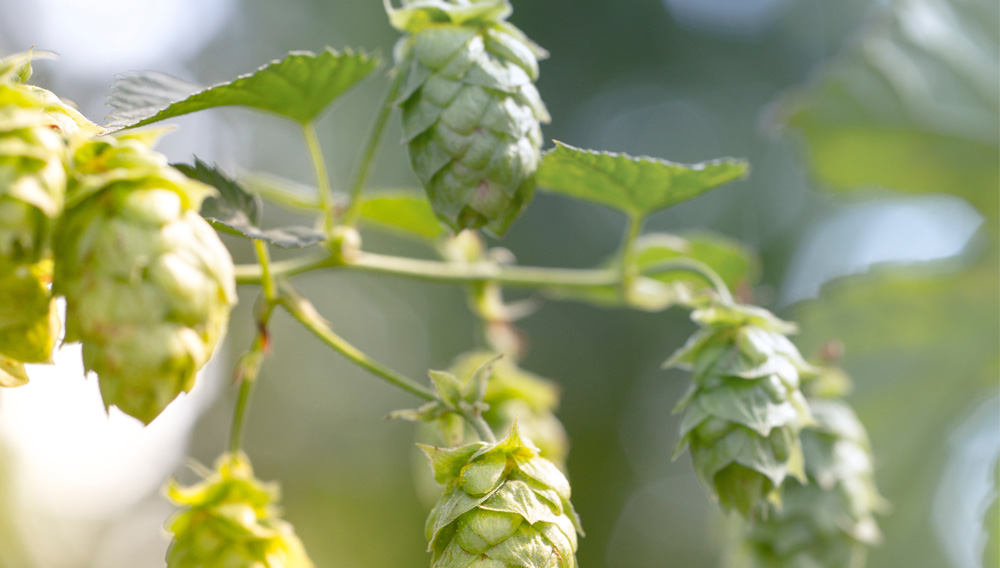
Hüll aroma hops | The climate change brings particular challenges for hop growers and brewers. Aurum, the new Hüll aroma variety with a Tettnanger background, presents itself not just as a climate-tolerant noble hops but also with a fine-hoppy aroma in combination with a pleasant subtle bitterness and lives fully up to its name in numerous brewing tests.

Test brews | Yield of hop bitter substances is key to efficient use of hops. However, solubility of α-acids in an aqueous environment strongly depends on pH value and temperature. In this respect, wort does not offer optimal conditions for adequate isomerisation of α-acids. When ionising water, a by-product having an alkaline environment is formed. This is used for isomerisation of hop α-acids and for raising yield of bitter substances.
Comprehensive guide | With the “Beer Brewing Guide – the EBC Quality Handbook for Small Breweries”, published in June 2021, the Brewers of Europe and the European Brewery Convention commissioned a new must-have book that provides small breweries and aspirational professional brewers with practical tips to improve the way they brew on all critical quality points, from receiving the ingredients to ensure their beer is poured the perfect way.
Historic brews | At Colonial Williamsburg, a 1.22-km2 (301-acre) “historic district and living-history museum” [1] in the heart of the small City of Williamsburg in the state of Virginia, history indeed comes alive … literally. As you stroll along painstakingly reconstructed residences, workshops, inns, and taverns dating from the late 18th century, interpreters and actors in period costumes recreate daily life from the time of the American Revolution (1775–1783), when such luminaries as the United States’ first president, George Washington, its third president, Thomas Jefferson, and its fourth president, James Monroe, walked the district’s streets.

Aging behavior | During experimental trials conducted to assess the reproducibility of the 2 hl pilot brewery at Hopfenveredlung St. Johann GmbH, it was determined that a number of hop aroma compounds were transferred from hops to beer. Subsequently, the behavior of these compounds in the finished beer over the course of aging was investigated [1].

Wet milling | The malting and the brewing industries are in a constant need of saving money, energy and lowering their carbon footprint. What if maltsters could skip the most energy consuming step of nowadays malt production, i.e. the kilning process? And what if brewers had a workable process to mill the green malt? This article presents an introduction to brewing with green malt with an innovative wet milling system comprising two sequential mills, the first being used for cutting and the second for crushing.

Single rest | Interest in reduced-alcohol and alcohol-free beers is growing. Can they also be produced by craft brewers? The authors describe a simple, isothermal mashing process in which temperature is maintained constant at 72 °C for 120 minutes. Using different malt mixes, original gravities will range from 10.6 to 12.1 °P. The alcohol content of the finished beer is between 1.9 and 3.5 per cent ABV and, when adding Saccharomycodes ludwigii, about 1 per cent ABV.

Beer color values in comparison | This is the last part in a three-part series of articles about beer color. Part 1 examined the evolution of color measurements of finished beers [1]. Part 2 outlined the logic behind five popular, malt-based, mathematical color predictors that are commonly used throughout the world at the recipe design stage [2]. Finally, this article looks at three beers brewed specifically for this study to evaluate the saliency and precision of the formulae presented in part 2 by comparing their predictions to actual laboratory color measurements.

Exhaust heat project | An innovative concept that uses fermentation and refrigeration compressor energy via heat pumps has been introduced in the Puntigam district of Graz in Austria. The modern heating system for a new residential estate of 800 flats is the result of a cooperation between Brauerei Puntigam, Kelag Energie & Wärme GmbH and C&P Immobilien AG.

Fatty acids and foam | It is common knowledge that beer foam and fat(ty acids) do not get along with each other [1, 2, 3]. However, technologies and raw materials are natural sources of fatty acids in wort and beer. The extent to which medium-chain fatty acids regarded as detrimental to foam play a role will be described in more detail in this article.

So far and yet so near | The impact of the Covid-19 pandemic on the regular operations of many companies has shown that we need innovative solutions to be able to also guarantee safety of investment in times of crisis. With customers in over 60 countries of the world, medium-sized systems manufacturer BrauKon from Seeon in Germany has also been hugely challenged by the imposed travel and contact restrictions. It therefore decided to fast-track the development of its remote commissioning process.





